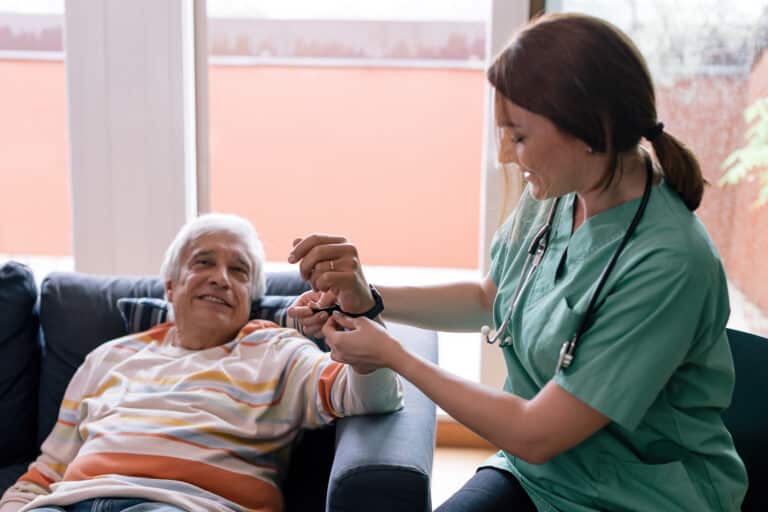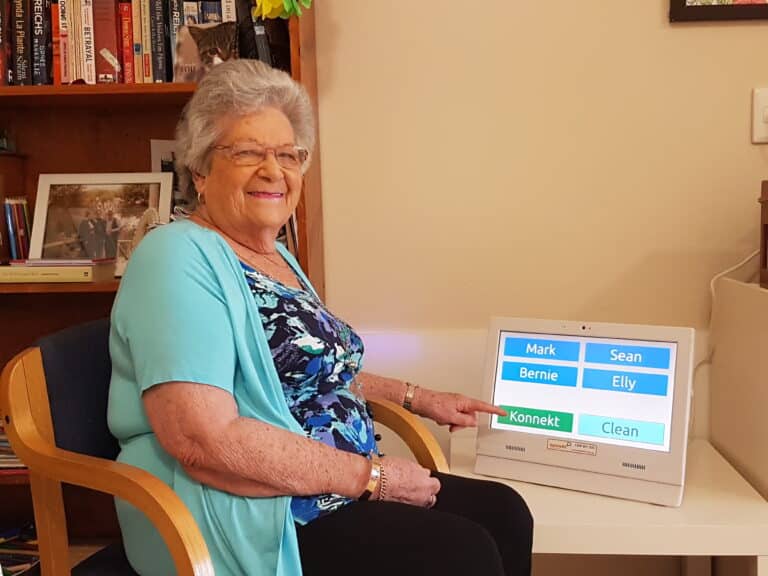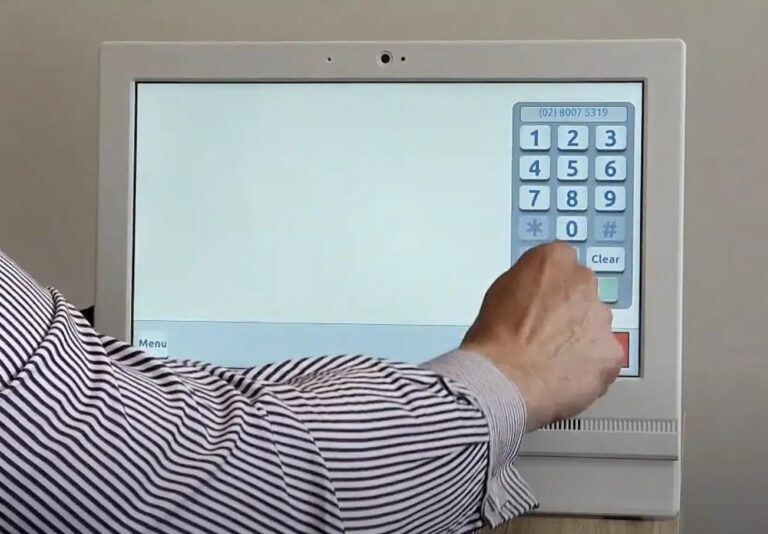Written by Xingyi Wu, May 2023:
Devices That Help the Elderly Living at Home
COVID, health concerns, immobility and social isolation. The reasons why the elderly people in our lives spend more time at home are multiplying by the day.
In fact, in recent research conducted by the United States’ Pew Research Centre, close to 1 in 3 American adults aged 60 years and older are currently living alone. This is just one example of why it’s becoming more important than ever before to find solutions for connecting older communities to the people around them.
Assistive technologies, like the variety of purpose-created communication devices that now exist across the market, are a great way of doing so in a manner that’s effective, dignified, and cost-viable.
Examples of devices that help the elderly living at home
- Emergency pendants
- Automatic fall detection devices
- Smart door hinges allowing for each access in case of door blockage
- Smart doorbells
- Big-button phones with additional features such as the Konnekt Videophone and Captioning Videophone

In this article, we will also consider:
- Why communicative technology is so important for the aging population
- How these devices can help not only elderly loved ones, but their families as well
- The types of assistive technologies available for this purpose
- Which communication devices are best for those living at home
Why do the elderly live alone?
The reasons that elderly people live alone are highly dependent on a number of factors – including country of residence, economic circumstances, and a person’s specific needs, interests and requirements.
In general, an older individual’s justification for living by themselves, without a coinhabitant or the daily care of another adult, may include:
- Wanting to maintain independence
- Social isolation due to health reasons or technological exclusion
- Following the death of a partner, spouse, friends or family members
- Lack of family presence or involvement
- The cyclical effects of loneliness
- Cultural reasons – particularly so in the West where family involvement can decrease across the lifespan
Recently, Harvard University’s Joint Center for Housing Studies reported that the share of solo households across the globe is steadily increasing, reaching 58% among those 80 and over – that’s far more than half of elderly people within that age group.
Of course, living alone also poses some risks to older individuals.

Examples of risks faced by elderly living independently
at home
- Social isolation
- Falls, injury and bone breaks
- Loneliness
- Poor or declining mental health
It doesn’t take much effort to see that, strangely enough, the reasons many elderly people live alone are similar to the risks posed by doing so. Thus, the cycle of social isolation often continues – unchecked, unmanaged and undiagnosed.
What if we shared with you that a safe, healthy and cost-effective intervention was possible?
Why are communication devices important for the elderly?
While many older people are becoming increasingly tech-savvy, it’s now widely acknowledged that those entering later life are less likely to be online than their younger counterparts.
For example, in 2019, of the 4 million people in the UK who have never used the internet, 94% were aged 55 and over, 84% were over the age of 65, and 62% were over the age of 75 (Centre for Ageing Better, United Kingdom).
Quite simply, communication devices are important to consider for the elderly because they address most – if not all – of the risk factors listed above.
With intelligent and well-designed assistive communication technologies, older people unable or unwilling to leave their homes can be helped to transform the way they interact with others, staying in more frequent contact with friends and family.
What’s more, these communication devices can help elderly individuals learn to better manage potentially intrusive thoughts and emotions (leading to declining mental health).
However, while more elderly individuals than ever before are now using this type of technology, the question remains over how best to assist people with learning how to use it (Forbes Magazine).
How can the elderly be encouraged to use communication devices?
Purpose-created assistive communication devices like the Konnekt Videophone and Konnekt Captioning Videophone not only address the many risk factors of elderly people living alone, but are also remarkably simple to teach and use.
Of course, there are a number of important factors that, if considered, will encourage the elderly people in your life to both learn and use them to better connect with loved ones.
Examples of worthwhile considerations
- Screen size
- An easy user interface (e.g. no so-called “menu-diving”)
- Assistive functionalities such as loud volumes, clear display, captioning and large buttons
- Ability to save and store frequently dialed numbers and contacts

When close to 40% of elderly people refrain from using the internet (Australian Bureau of Statistics), it helps to both understand and address the factors as to why.
The good news?
Unlike smartphones, tablets and other mobile devices, Konnekt’s products are specifically designed for elderly people, meaning your loved ones’ dignity will be respectfully retained while they adapt to the presence of technology in their life.
You can read more about the philosophy that forms the foundation of our products here.
Suggested devices for the elderly
As the digital lives of older individuals continue to expand, so too do the technological options available to them.
But which of these options is best? Let’s take a closer look:
Emergency pendants
An emergency on “panic” pendant is a small, portable, battery-operated device that ensures your loved one always has access to help during an emergency situation, such as a break-in or debilitating fall.
While these smart devices can provide safe and timely help in an emergency situation, some elderly people report an unwillingness to wear them due to aesthetic reasons or feelings that such a device does not provide a particularly dignified way of living.
Automatic fall-detection devices
These types of smart sensors, usually worn on either the wrist or as a pendant around the neck, works with innovative fall detection software with measures of loss of altitude and speed, detecting if a person is likely to have fallen from an upright position. Importantly, the wearer of the technology can also call for help directly from their device.
Despite its significant list of benefits, the same list of aesthetic considerations and concerns may also apply to those considering purchase of the device.
Smart door hinges allowing for each access in case of door blockage
“Smart door” or “lift-off” hinges are a type of hinge made up of two parts. These special hinges allow for easy door removal from the room’s exterior without the need to open the door. These are especially useful in case of fall or interior blockage of the doorway.
Smart doorbells
A smart doorbell is a (usually) internet-enabled technology that incorporates elements such as a camera, microphone and doorbell function in a single, mountable unit. Typically, smart doorbells allow you to hear, see and video record anyone who visits your door.
Some disadvantages of smart doorbells is that, in some cases, they may slow your internet connection, or include false alarms in the case of movement detection of animals, plants or other environmental features.
Big-button phones with additional features such as the Konnekt Videophone and Captioning Videophone
All Konnekt products are specifically designed to be super-simple to use with a range of incredible features to make living at home a comfortable, safe and dignified experience for the elderly person in your life.
You may like to hear directly from our hundreds of satisfied customers by reviewing our testimonials here.

Examples of our product features
- 15-inch touch screen
- 6-inch buttons with huge text – large, and easy to see and press
- Twin loud speakers
- Captioning ability in multiple languages (Captioning model only)
- Personalised call list to any device
- A huge range of additional accessibility options
Which device is best for helping elderly people living at home?
We understand: it’s likely that deciding on the best device for helping the elderly person in your life can seem like a difficult and daunting decision – much like other care-related decisions you’re likely to be facing.
To find out more about Konnekt’s products or to have an obligation-free discussion with our team about best-fit options for you and those you love, visit our website and we’ll get right back to you.
We can’t wait to meet you.
Available worldwide
Konnekt has sales/support partners across Australia / Asia, Europe, United Kingdom, North America, New Zealand and Africa.
